The global forklift market is undergoing a significant transformation, driven by e-commerce expansion, automation, and sustainability mandates, with projections indicating it will surge to $125.42 billion by 2030 . Forklifts, essential material handling equipment, are broadly categorized into internal combustion, electric, and warehouse-specific models, each designed for distinct operational environments. Internal combustion forklifts, powered by diesel, gasoline, liquefied petroleum gas, or natural gas, excel in outdoor or rugged settings such as ports, steel mills, and construction sites due to their robust power and continuous operation capability. With load capacities ranging from 1.2 to 52 tons, they include subtypes like standard counterbalance forklifts for general hauling, heavy-duty models for demanding tasks, container handlers for port operations, and side-loaders for long loads like timber or pipes . In contrast, electric forklifts, powered by batteries and producing zero emissions, are ideal for indoor applications in sectors like pharmaceuticals and food processing. Their load capacity typically spans 1.0 to 8.0 tons, and they operate quietly without polluting the air, though they require battery charging or replacement after approximately eight hours of use . The shift toward electric models is accelerating, fueled by environmental regulations and lower total cost of ownership, with Class I and III electric forklifts gaining particular traction in logistics and manufacturing .
Warehouse forklifts, engineered for space-efficient indoor logistics, include a variety of models tailored to narrow aisles and high-rise storage systems. Electric pallet trucks, for instance, handle horizontal transport with capacities of 1.6–3.0 tons and require aisles just 2.3–2.8 meters wide, while order pickers facilitate efficient piece-order fulfillment at heights up to 10 meters . Reach trucks enhance storage density by operating in aisles as narrow as 2.7–3.2 meters and lifting loads up to 11 meters high, and three-way stackers further optimize space by allowing left-right stacking without turning the vehicle, suited for very narrow aisles of 1.5–2.0 meters . Beyond these, specialized forklifts like telescopic handlers offer unparalleled versatility with extendable booms, multiple steering modes, and attachment compatibility—such as forks, buckets, or clamps—enabling them to tackle tasks from construction lifting to agricultural handling. For example, models like the ZTH4518R provide up to 18 meters of lift and 4.5-ton capacity for bridge-building or installation projects, while compact units like the ZTH2506 navigate tight spaces in warehouses or underground parking garages with widths as minimal as 1.84 meters . Additionally, rough-terrain forklifts with all-wheel drive and high ground clearance perform reliably on uneven surfaces, and explosion-proof models ensure safety in hazardous environments like chemical plants .
Technological advancements are reshaping forklift capabilities, with intelligent and autonomous systems leading the way. Smart forklifts integrate features like LiDAR, SLAM navigation, and real-time data synergy with warehouse management systems (WMS) to enable fully automated operations, including path optimization and collision avoidance . According to industry analyses, the adoption of unmanned forklifts is rising rapidly, with China's expected to reach 39,000 units by 2025, driven by labor cost increases and automation policies . Energy innovations are equally transformative; lithium-ion batteries offer extended runtime and faster charging, while hybrid solutions like Hangcha Group's X Series blend diesel and electric power to deliver fuel savings over 35% and mitigate range anxiety in heavy-duty applications . Attachment versatility further extends functionality—forklifts can be equipped with rotators, clamps, or push-pull devices to handle diverse materials from paper rolls to barrels, maximizing ROI across sectors . The industry's competitive landscape features key players such as Toyota Industries, KION Group, and Jungheinrich, who are focusing on electric and autonomous solutions to meet evolving demand .
Choosing the right forklift hinges on a detailed analysis of operational requirements, including load weight, lift height, aisle width, and fuel preferences. For instance, electric models are optimal for multi-shift indoor operations if spare batteries are available, whereas internal combustion units are better for intense outdoor use . The market's trajectory points toward electrification, automation, and specialization, with North America and Asia-Pacific leading growth . As businesses strive for higher efficiency and sustainability, understanding these forklift types and their applications becomes crucial for optimizing logistics and maintaining a competitive edge in the evolving material handling industry.
Post time:Oct.13.2025



